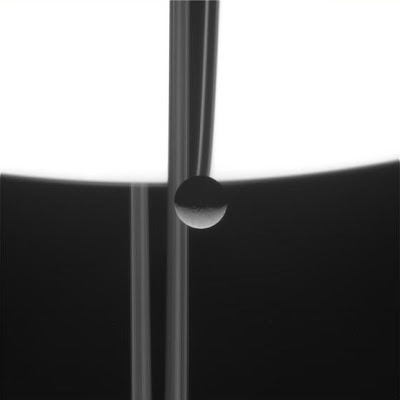Happy Tenth, Cassini!
Cassini has been at Saturn for ten years now. Ten years! From among my favorites:
There are four moons here:

The most obvious one is Dione, of course, bright and in the center of the shot. Behind Dione is giant Titan. Off to the right, at the tip of the rings, is little Pandora, an F-ring shepherd. Did you find the fourth one?
Look at the rings. See the dark gap? That's the Encke gap. Look closely. See the bright speck? That's Pan - tiny, tiny Pan, only 35 km (21.7 miles) across. Pan is a ring shepherd, and helps maintain the Encke Gap, keeping it clear of ring particles.
Here's a truly stunning image from Cassini, Rhea and the rings. It's raw, unprocessed - and amazing.

 What moon is that? How can a moon of Saturn be so centered on the A Ring?
What moon is that? How can a moon of Saturn be so centered on the A Ring?Well, it can't. That's no moon, folks, that's a star! And it's behind the rings.
It's Mimosa, aka Beta Crucis, the bright left-hand star in the Southern Cross. The rings, being particles, let light through, and this star's so bright it looks as though it's in front.

Cassini took this picture in infrared (which is why it's dark) just as Rhea moved behind Saturn. Further out along the rings are Tethys and Enceladus at far left.
As always, see the Cassini home page for more.





























0 Comments:
-
<-- Older Post ^ Home Newer Post -->Post a Comment
Subscribe to Post Comments [Atom]